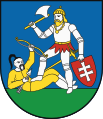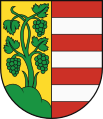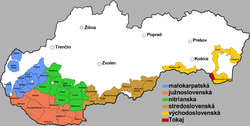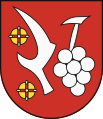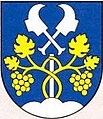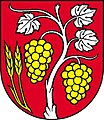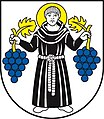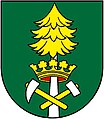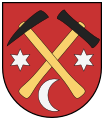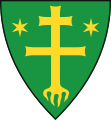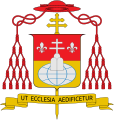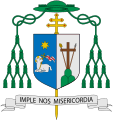
Banská Bystrica is a city in central Slovakia, located on the Hron River in a long and wide valley encircled by the mountain chains of the Low Tatras, the Veľká Fatra, and the Kremnica Mountains. With approximately 76,000 inhabitants, Banská Bystrica is the sixth most populous municipality in Slovakia. The present-day town was founded by German settlers, invited by the Hungarian Árpád-kings, during the Middle Ages, however it was built upon a former Slavic/Slovakian/Avar settlement. A part of Zolyom county after the Hungarian conquest. During the reign of Béla IV of Hungary it obtained the municipal privileges of a free royal town of the Kingdom of Hungary in 1255 and resettled with Germans from Thüringen. The copper mining town acquired its present picturesque look in the late Middle Ages when the prosperous burghers built its central churches, mansions, and fortifications. It is the capital of the kraj and the okres. It is also the home of Matej Bel University. As a historical town with an easy access to the surrounding mountains, Banská Bystrica is a popular winter and summer tourist destination.

Banská Štiavnica is a town in central Slovakia, in the middle of an immense caldera created by the collapse of an ancient volcano. For its size, the caldera is known as the Štiavnica Mountains. Banská Štiavnica has a population of more than 10,000. It is a completely preserved medieval town. Because of their historical value, the town and its surroundings were proclaimed by the UNESCO to be a World Heritage Site on December 11, 1993.

The current form of the national flag of the Slovak Republic was adopted by Slovakia's Constitution, which came into force on 3 September 1992. The flag, like many other flags of Slavic nations, uses Pan-Slavic colors. Pictured to the left of centre of the flag is Slovakia's national coat of arms.

Kremnica is a town in central Slovakia. It has around 5,300 inhabitants. The well-preserved medieval town built above important gold mines is the site of the oldest still-working mint in the world.

Matica Slovenská is the oldest Slovak national, cultural and scientific organization. The headquarters of Slovak Matica is the town of Martin, Slovakia as the center of the national culture of Slovaks, where it was founded in 1863 and revived in 1919. Slovak Matica is a public institution that operates as a national scientific and cultural centre. It has facilities both in the Slovak Republic and abroad. Slovak Matica works to develop and protect the national rights, identity, and development of Slovak culture and the Slovak nation. Slovak Matica is a legal entity. It establishes its organizational units on the territory of the Slovak Republic as well as abroad. The position and activity of Slovak Matica is regulated by Act no. 68/1997 Coll. on the Slovak Matica as amended and the Statutes of Slovak Matica.

The coat of arms of the Slovak Republic consists of a red (gules) shield, in early Gothic style, charged with a silver (argent) double cross standing on the middle peak of a dark blue mountain consisting of three peaks. Extremities of the cross are amplified, and its ends are concaved. The double cross is a symbol of its Christian faith and the hills represent three symbolic mountain ranges: Tatra, Fatra, and Matra.
Detva is a town in central Slovakia with a population of 14,686. It is situated beneath the mountain Poľana.
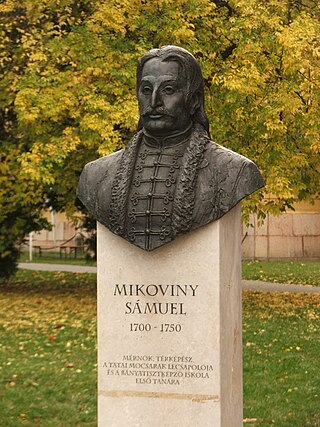
Sámuel Mikoviny was a mathematician, engineer, cartographer, and professor. He was a leading representative of science and technology in the 18th century Kingdom of Hungary and Habsburg monarchy.

Žiar nad Hronom is a city in Banská Bystrica Region, Slovakia.

The lion is a common charge in heraldry. It traditionally symbolises courage, nobility, royalty, strength, stateliness and valour, because historically the lion has been regarded as the "king of beasts". The lion also carries Judeo-Christian symbolism. The Lion of Judah stands in the coat of arms of Jerusalem. Similar-looking lions can be found elsewhere, such as in the coat of arms of the Swedish royal House of Bjelbo, from there in turn derived into the coat of arms of Finland, formerly belonging to Sweden.

Nová Baňa is a small town in the west of central Slovakia and the largest town of the Žarnovica District, located in the Banská Bystrica Region.

Vinosady is a village and municipality in western Slovakia in Pezinok District in the Bratislava Region, on the foothills of the Little Carpathians.
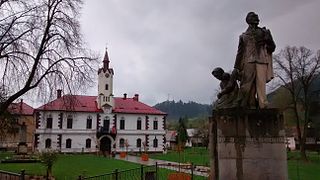
Ľubietová is a village in central Slovakia. Originally an ancient mining town, it is known for precious minerals.
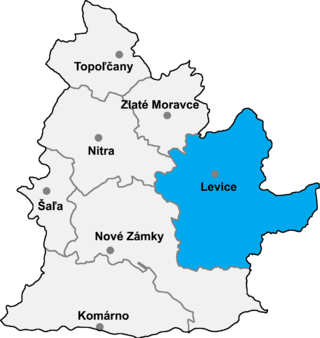
Rybník is a village and municipality with 1420 inhabitants in the Levice District in the Nitra Region of Slovakia.

Kúty, is a village and municipality in Senica District in the Trnava Region of western Slovakia.
Finnish heraldry has a common past with Swedish heraldry until 1809 and it belongs to German heraldric tradition.
A heraldic authority is defined as an office or institution which has been established by a reigning monarch or a government to deal with heraldry in the country concerned. It does not include private societies or enterprises which design and/or register coats of arms. Over the centuries, many countries have established heraldic authorities, and several still flourish today.
In heraldry, a mount is a representation of a hill or mountain as a curved terrace in base. When the mount is included in the lower part of the shield, it may be considered an ordinary rather than a charge.

Ladislav Čisárik was a Slovak heraldic artist, painter, and graphic designer. In 1990, Ladislav Čisárik and Ladislav Vrtel co-designed the coat of arms of Slovakia, the current flag of Slovakia, and the presidential standard of the president of Slovakia. He also designed or modified the coat of arms and seals for more than 100 towns and municipalities in Slovakia.





